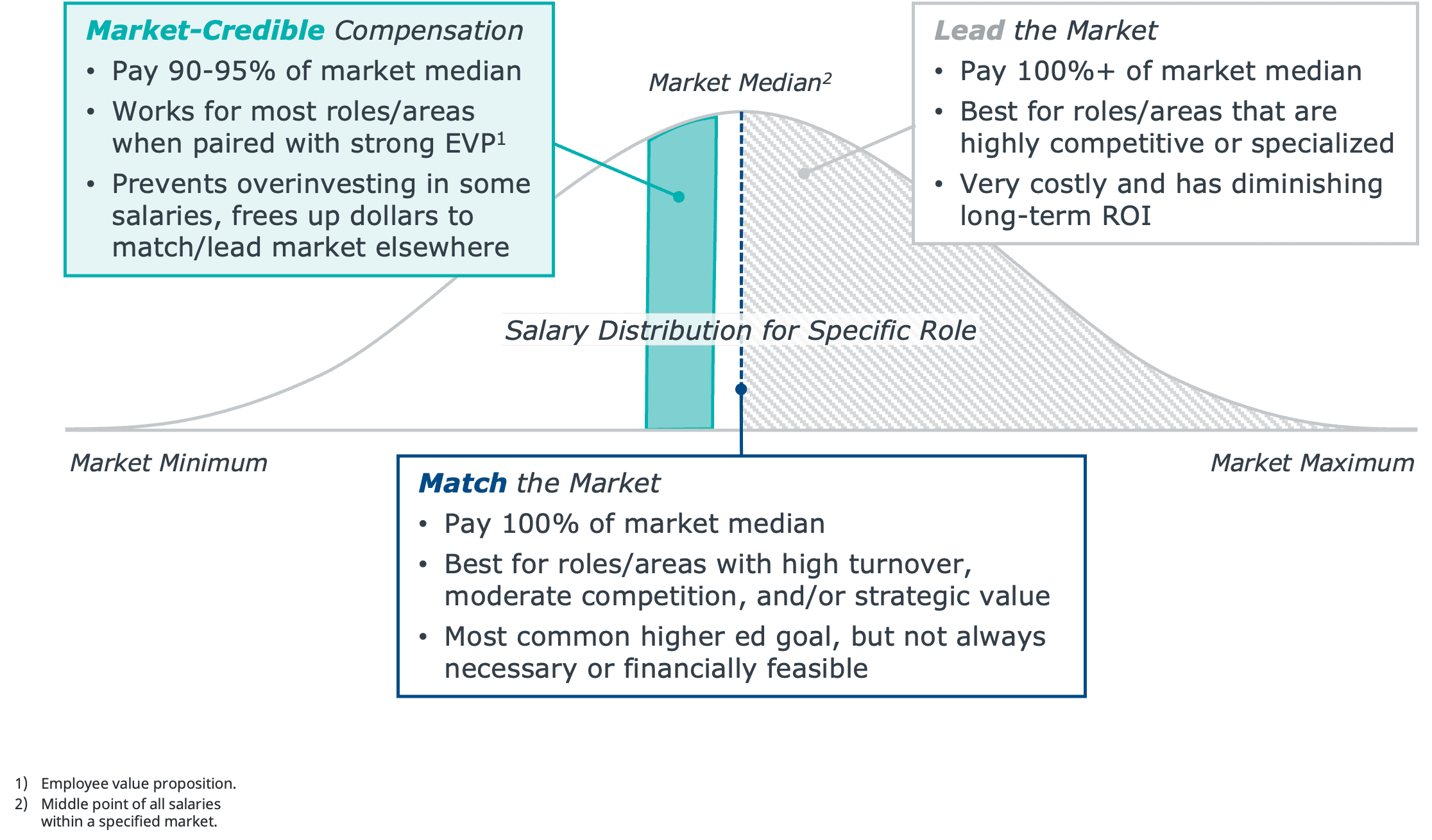Higher ed can’t beat the market on staff compensation. Here’s how to be market-credible instead.
3 staff compensation strategies to maximize your college's limited resources
February 7, 2024, By Brooke Thayer, Senior Director, Research Development
Higher ed staff often cite pay as a top reason they seek employment elsewhere, and more than half feel they are not being paid fairly. But most colleges and universities lack the resources to match market rate for every role and unit across campus. A match-the-market approach can also lead to institutions under- or overinvesting in compensation for certain roles and units, reducing the impact of scarce salary dollars on staff recruitment and retention.
Instead, cabinet and HR leaders must instead recalibrate their compensation strategy to make best use of limited compensation resources. Read on to learn about three key staff compensation strategies and when to prioritize using each.
Three market-based pay strategies

Pay strategy #1: Aim to offer “market-credible” compensation for most staff roles
Many cabinet leaders assume their college or university must at least match the market on staff salaries to attract and retain talent. But for some roles and functional areas, institutions do not need to pay market rate to compete. Instead, they can offer “market-credible” pay that is 90-95% of the market median―so long as they make regular salary adjustments (e.g., cost of living) and invest in providing non-salary benefits that staff value (e.g., career development and advancement).
Paying slightly below the market for certain roles and/or functional areas enables cabinet and HR leaders to free up resources to make more targeted investments in matching or leading the market in cases where it is truly critical for staff recruitment or retention.
Market-credible compensation best supports strategic goals like:
-
Improve long-term financial sustainability
-
Contain labor costs
-
Free up resources via salary savings
Pay strategy #2: Match the market for select roles or functional areas with strategic value, specialized skills, or high levels of competition
In most cases, cabinet and HR leaders should aim to provide market-credible compensation. However, there are cases where this will not suffice—such as highly specialized or ultra-competitive fields like IT.
Cabinet and HR leaders must invest more resources in matching the market in these priority areas. When determining which roles or functional areas warrant a match-the-market approach, they should consider factors like the criticality of the role to campus operations, strategic alignment with university goals, the skills and experience required for success, and competition levels.
Matching the market best supports strategic goals like:
-
Reduce pay dissatisfaction among staff
-
Strengthen staff engagement
-
Stabilize staff turnover rate(s)
Pay strategy #3: Only seek to lead the market when matching does not yield desired staff recruitment and retention outcomes
Leading the market should be a last resort for most colleges and universities. In fact, top-of-market pay can be more inefficient in the long run. That is because pay is a “hygiene factor,” meaning when it is too low people will leave but making it ever higher has diminishing returns. Some studies show that staff who are paid at or above market rate are often still not satisfied with pay.
So while there is a perception that paying staff above market rate will retain them, that is not always the case―especially for staff with specialized skills that are in high demand. Even if hiring managers can woo top candidates in high-demand areas with top-of-market salaries, they often turn over quickly since other employers are desperate to poach them. This can further drive up institutional costs and reduce the long-term financial sustainability of this strategy.
Leading the market best supports strategic goals like:
-
Strengthen overall size and quality of talent pipeline for specific roles
-
Successfully attract/recruit top talent, especially in high demand areas or with technical skills or superior experience
How do I set appropriate pay targets for my campus?
Cabinet and HR leaders should use EAB’s Competitive Pay Target Selector, which is part of EAB’s Market-Credible Staff Compensation Playbook, to determine the right targets for different functional areas and/or roles at their institution. This tool outlines common staff compensation strategies and their use cases before providing leaders with a diagnostic tool to assess when to prioritize matching/leading the market.

More Blogs

How to avoid 3 common salary study mistakes in higher ed

How to target higher ed salary investments to bolster recruitment and retention
